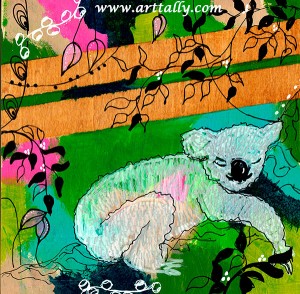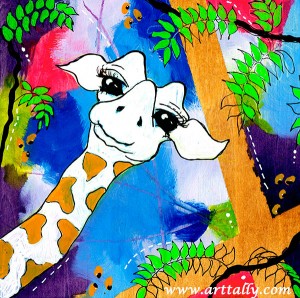Did you know these intriguing koala facts?
 Koalas are adorable, cuddly looking creatures. While gathering fascinating koala facts, I noticed that koalas have some fairly human qualities like opposable thumbs and fingerprints. But being marsupials they have other rather intriguing characteristics too...
Koalas are adorable, cuddly looking creatures. While gathering fascinating koala facts, I noticed that koalas have some fairly human qualities like opposable thumbs and fingerprints. But being marsupials they have other rather intriguing characteristics too...
Did you know...?
- Koalas have two opposable thumbs on their front paws
- Koalas have similar fingerprints to humans
- Koalas are excellent swimmers, and may cross rivers in order to escape from heavy flooding in one area.
- Koalas don't live in one single tree - their ‘home' is made up of several trees called Home Trees in an area described as the Home Range. They visit these same trees regularly.
- A mature male koala marks his territory by rubbing the dark, sticky substance from the scent gland in the centre of his white chest on his trees.
- The size of each home range depends upon a range of factors including the quality of the habitat and the sex, age and social position in the population of the Koala.
- Koalas are rather anti social...Unless breeding, they don’t normally visit another Koalas home trees and only spend 15 minutes a day in social activity.
- A baby koala (joey) is born only 33-35 days after being conceived - (don't tell Mrs Whale... that poor love gets to be pregnant for two years!).
- When the Joey is born, it’s only about 2 centimetres long, is blind and furless and its ears are not yet developed.
- The joey makes an amazing journey to the pouch, relying on its strong forelimbs and claws, its well-developed senses of smell and touch, and an inborn sense of direction.
- Once in the pouch, it attaches itself to one of the two teats which swells in its mouth, preventing it from being dislodged from its source of food.
- The Joey stays in its mother’s pouch for about 6 or 7 months, drinking only milk.
- Gum leaves are toxic to most.. even to baby koalas! Don't even ask how the joey is weaned from milk to gum leaves....
Want to see some more of these beautiful, but vulnerable creatures? Why not head over to Healesville Sanctuary, either in person or a cyber visit! Healesville Sanctuary is quite my favourite place to go visiting koalas.
A very good reason my kids are glad not to be a baby koala
 Who doesn’t love a koala? My children adore them. In fact for a while they thought it would be great to actually be a baby koala.
Who doesn’t love a koala? My children adore them. In fact for a while they thought it would be great to actually be a baby koala.
We went to a birthday party recently with the ‘zoo that comes to you’. Rather impressive all told. In their friend’s living room the children got to see and touch and learn about a whole lot of Australian animals… not least of which was a koala.
They learned all sorts of things about all the animals. They even got to cuddle a koala. And they learnt one very good reason to be really glad that they are not koalas, after all.
I totally see the appeal of the baby koala and why they thought being one might be a good idea. Koalas are cute and cuddly… just like a teddy bear. That is why some people call them koala ‘bears’. It’s a misnomer - they are not bears at all, but marsupials.
And the life of a baby koala seems pretty OK…. Koalas sleep for 18-20 hours every day and spend the rest of the time eating. They live in trees - they even sleep in trees (this holds enormous appeal to those under 8!) When they are hungry the trees they live in provide all the food they want, ready to hand. They don’t usually need to drink much either as the leaves they consume provide significant moisture for them.
A baby koala is carried by the mother, tucked in her cosy pouch for about 6 months. They also ride on mummy koala’s back or abdomen. The baby koala stays with mum for 1-3 years. The easy life. All rather sweet.
But… and for my children it is a rather big ‘but’…
Gumleaves are toxic to most animals, including a baby koala. When they begin weaning off their mother’s milk, their digestive systems are not yet mature enough to tolerate the gum leaves. So instead they get to eat their mothers poop…
Yes, I’m afraid so. It is called ‘pap’ and it is a special form of predigested gumleaves made just for the little joey.
This does not comfort my children.
The pap is a specialised form of the mother’s droppings that is soft and runny. It allows the mother to pass on to the baby koala (joey) special micro-organisms from her intestine which are necessary for it to be able to digest the gumleaves. The joey will feed on this for a few weeks, just before it comes out of the pouch at about 6 or 7 months of age.
So maybe my children don't get to sit about in trees all day sleeping and eating like koalas do. But they haven't complained quite so much about my dinner menu recently either…
Thanks, Zoo that comes to you…. I’m calling that a parenting win.
Do you know these surprising facts about whales?
In honour of the fourth and final whale in my series of animal panels I have put together a collection of surprising facts about whales. They are truly amazing creatures. Did you know....
Only one half of the whale’s brain sleeps at a time. This is because whales are mammals and cannot breathe under water. At all times they need enough brain function to keep breathing by swimming to the surface.
Sperm whales dive down to the ocean floor and then catch a nap standing up. Their naps last about 12 minutes during which time they rise slowly to the surface in their upright position, head first.
Whales are believed to have descended from land animals that returned to the water roughly 50 million years ago after living millions of years on land.
The beluga whale is actually capable of facial expressions. Some times the beluga appears to be smiling or frowning as its lips and the crescent of fat that forms the forehead are both highly mobile
Some amazing adaptations of the sperm whale include the ability to limit blood circulation to the brain and other organs, slow the heart to 10 beats per minute to conserve oxygen, and collapse the lungs and rib cage. These unique physiological adaptations are necessary to withstand the intense cold and crushing pressure of the sperm whale's two mile dives.
Toothed whales hunt their prey using echolocation. The reliance on sound as the whale's most critical sense explains the small size of their eyes relative to their bodies
Blue whales are the loudest creature on earth. Like all baleen whales they use sonar communication at very low frequencies. The blue whale's cry measures 188 decibels - louder than a jet which is 140 decibels.
The enormous weight of the whale is supported by the water rather than large heavy bones which it would require if it were on land. A blue whale would be crushed by its own weight on land given its bone structure
Whales do not actually drink any seawater - they extract water from their food by metabolizing the fat
Some whales don't have teeth - they have plates called baleen which filter fish from the water which are then swallowed whole. Baleen is made of keratin like hair and nails. Sometimes baleen whales are referred to as ‘mustached’ whales
Whales move through the water by moving their tails up and down vertically - this is different from fish who move their tails horizontally to swim
The heart of the blue whale weighs about 1000 pounds and is about the size of a VW Beetle. A human child would be able to crawl through the aorta to the heart.
Killer whales and pilot whales are actually classed as dolphins not whales, despite their name
If you want to know more about these awe-inspiring creatures you might want to start here.
Have a whale of a day!
Want to know about Girl Power?... Ask these whales
 Ok I know I am going out on a limb here as whales are probably not the totem that springs to mind when we think of girl power. But maybe it should be.... did you know....
Ok I know I am going out on a limb here as whales are probably not the totem that springs to mind when we think of girl power. But maybe it should be.... did you know....
Whales have BFFs
Yes, they do!
The Mingan Island Cetacean Study group have discovered that female humpback whales not only make friends with one another but reunite each year. Whales are not as unsociable as was once thought. They remember their friends and even find them across the ocean and among other whales.
As any BFF knows, friendship is good for you. Even if you are a whale. Female humpbacks who form friendships are healthier and give birth to more calves each year. When they meet up with each other they simply float along together, eating and enjoying each other’s company. Some of these friendships are known to have lasted up to 6 years.
Interestingly, friendships between females and males (or even male-male friendship) are mostly unheard of. No one quite knows why, but only the girls have BFFs.
Whales have midwives
When a calf is born, the mother whale is usually surrounded by midwives. While the mother recovers the these midwives help the newborn stay at the surface so that it can breathe.
And mother whale deserves the support, if you ask me - blue whales are pregnant for nearly two years! A blue whale calf is 7.5m long at birth. The baby blue whale gains 3.7kg an hour until it is about 8 months old. By this time it weights about 22.5 tonnes. That's a lot of nursing....
The baby blue whale drinks enough milk to fill a bathtub every day. The milk from the blue whale has the consistency of cottage cheese and is about half fat. No wonder someone wrote a poem about milking a whale...
Whales value motherhood
Some female beluga whales have been seen carrying small objects, floats or buoys and even complete caribou skeletons on their heads or backs. The whales treat these objects like calves. Scientists surmise that for the whales, these objects are surrogate babies. Aww.
A group of sperm whales adopted a bottlenosed dolphin with a deformed spine. It is thought that the misshapen dolphin would have been rejected by his own kind, or simply not been able to keep up with them. However, the dolphin was taken in by the gentle whales.
Go on... spread the love...Why not share this post with your BFF today?
Fun facts about the giraffe
 Whenever I pick a subject to draw and paint in a series like this, one of my favourite things to do is to investigate the subject a little further. Totally nerd up the whole process.
Whenever I pick a subject to draw and paint in a series like this, one of my favourite things to do is to investigate the subject a little further. Totally nerd up the whole process.
With the giraffe, that research process has been well worth while. Check out these fun facts about the giraffe:
- giraffes only need 5-30 minutes sleep per day. They often take little naps that last only a minute or two, and can rest standing up
- the lungs of the giraffe hold 55 litres of air
- a giraffe's heart is 0.6m long and weighs 11 kg. It is the largest of any land mammal.
- NASA did research on the valves in the blood vessels of the giraffe to aid in the design of space suits. In order to protect the giraffe’s brain from sudden changes in blood pressure when it lowers its head to drink, it has valves to stop the back-flow of blood and elastic-walled vessels that dilate and constrict to manage flow
- the giraffe has a blue-purple tongue that is 53cm (21 inches) long. It is thought that this dark colour on the tip is to protect the tongue from sunburn as it is mostly out gathering leaves.
- the giraffe’s tongue has thickened papillae, which helps to protect it from the vicious thorns of the Acacia tree that it favours. In addition, thick saliva is also believed to help to protect the giraffe’s tongue and mouth against the defensive mechanisms of their favourite food.
- giraffes eat most of the time, chewing the cud like cows do and eat about 34kg of leaves per day
- despite its significant length, the giraffe's neck is not long enough to reach the ground so in order to drink so it has to kneel or spread its front legs
- although some people think that the giraffe does not make a noise, it can moo, grunt, hiss and snort - it just usually chooses not to. Studies also suggest that giraffe can communicate with sounds that are below the level of human hearing.
- the beautiful patterns on the giraffe are designed to camouflage them in the African plains. Like fingerprints, no two giraffe have identical markings.
- the giraffe species name is Giraffa camelopardalis because it has a small hump between its neck and its back and can go for many days without drinking like a camel, and because its markings are similar to the leopards 'spots'.
If you have still not had enough of giraffes, you might want to head over to the National Geographic website to check out a range of photos and facts about the awesome giraffe. You might also enjoy the comprehensive information from the San Diego Zoo over here.
It's a rough start if you are a baby giraffe!
Giraffe no 2 Mixed Media on Wood Panel by Kerrie Woodhouse
It amazes me how graceful a giraffe is with that long neck and spindly legs that seem to go on forever. It seems to me that having these attributes could actually be a bit awkward.
It certainly makes it interesting when a baby giraffe is born. The mother giraffe gives birth standing up. When you consider that a mother giraffe can be as tall as up to about 6 metres (20 feet), those baby giraffes get a pretty rough start to life!
After a 15 month gestation period, the baby giraffe (calf) commences life with a fall to the ground of almost 2 metres. No matter... within the hour the baby giraffe is usually up and about. A giraffe calf can run 10 hours after birth. Rather impressive.
A giraffe calf weighs around 100 kilograms and is about 2 metres tall at birth. This height will be doubled in the first year. Calves stay with their mothers until they are 15-18 months old.


